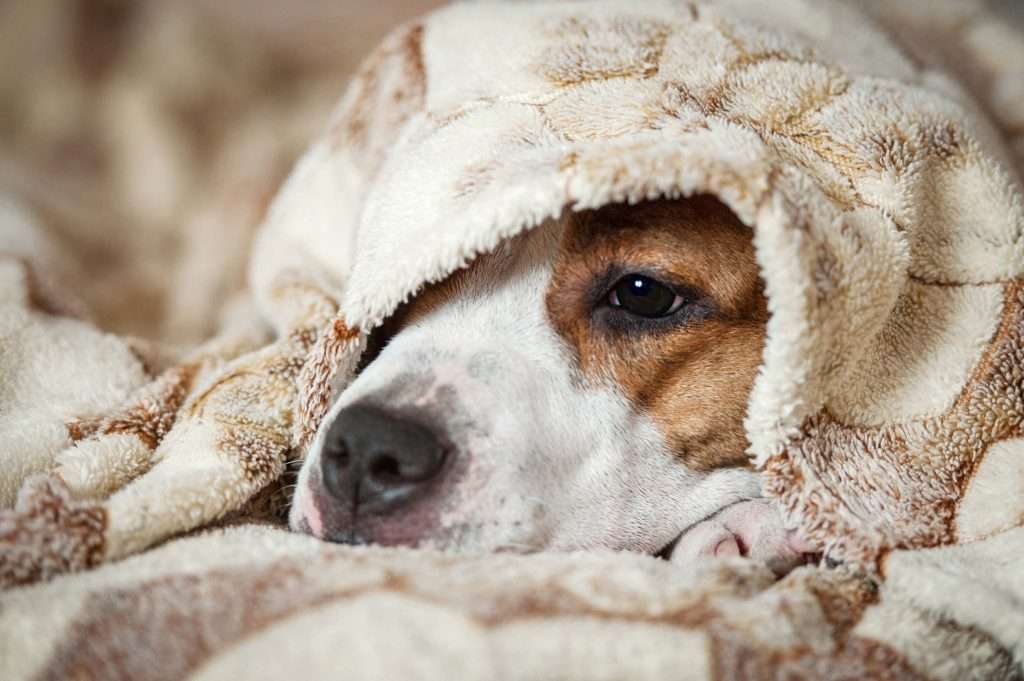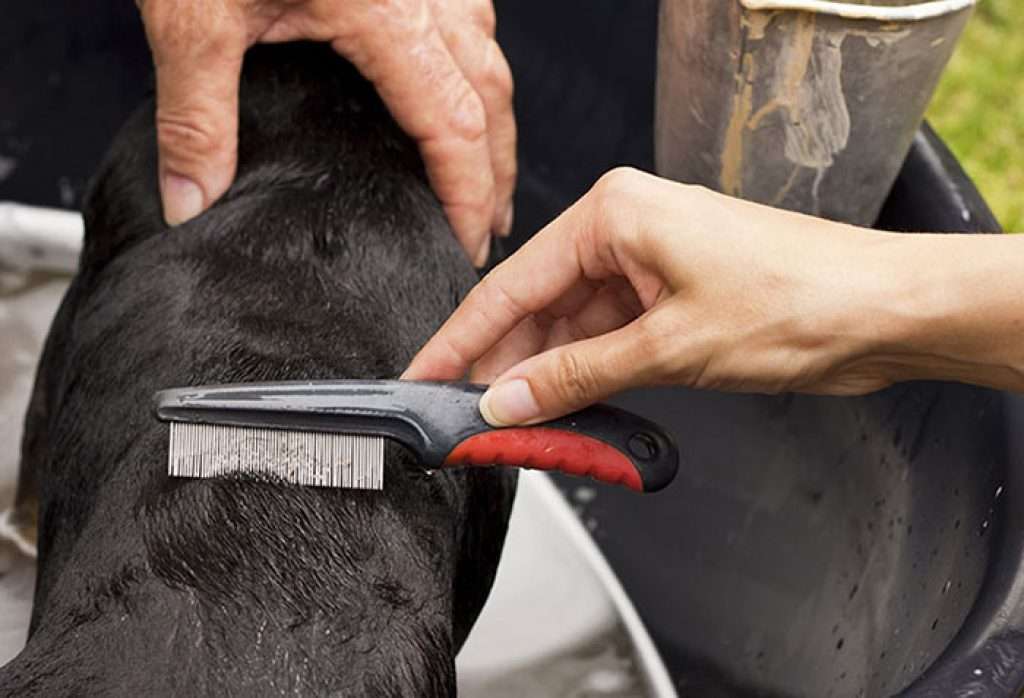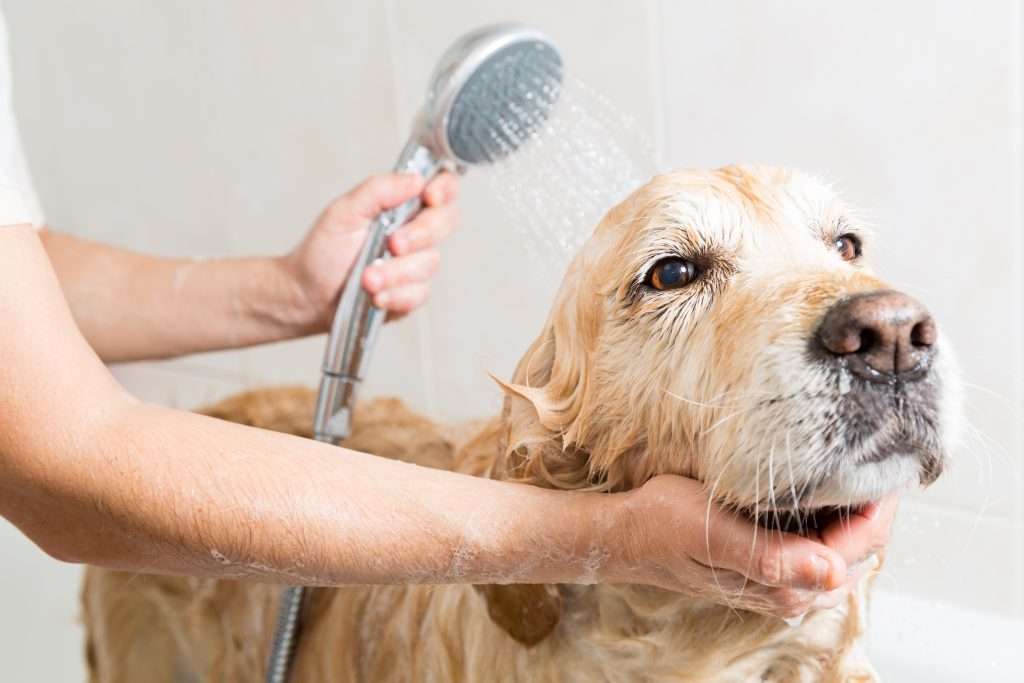Fleas are invasive bugs or parasites that harm our pets and affect us humans too! They suck blood from their hosts, and they can live between 14 days to one year. They can quickly adapt to their environment and become stronger and more immune to the popular chemical products with each generation.
About 95% of flea eggs, larvae and pupae live in your pet’s surroundings and not on its fur. So if you find a lot of fleas on your dog’s body, then there’s probably a lot more in your house!
Fleas can be a big problem, and if you think your pet has them, they need to be taken care of as soon as possible.
There are many safe and effective treatments and products that can prevent and stop their spread and some natural remedies!

Signs and Symptoms
How do you know if your dog has fleas?
Below is a checklist of common signs and symptoms. If you answered yes to any of these questions, your dog might have fleas.
- Is your pet scratching often?
- Does your dog’s skin look irritated, red, or have scabs?
- Areas of hair loss, bald or sore patches?
- Red pimples or bumps?
- Can you see tiny dark specks in its fur or small browny-black insects scurrying about?
- Do you have any insect bites yourself?
Fleas are tiny and very difficult to see. The only effective way to see them is to remove them with a fine-toothed flea comb. When you comb your dog, fleas or droppings will surface. Add a few drops of water, and if the droppings turn reddish-brown, your pet likely has fleas.
What Fleas can do to your Dog
- Flea bites can make your pet uncomfortable and itchy, causing uncontrollable scratching. Some pets may even suffer an allergic reaction if hypersensitive to the flea’s saliva.
- Fleas feed on blood. In extreme circumstances, your pet can become weak and may even die due to blood loss.
- Flea bites will cause your dog to feel uncomfortable and to constantly scratch, leading to visible patches of hair loss and red, irritated skin.
- The flea larvae can become infected with tapeworm eggs. If your pet eats an infected flea, it can become a host to this parasite.
- Plus, fleas can cause serious health problems, like dermatitis and anaemia.
How to Prevent your dog Attracting Fleas
Many treatments are available to treat a dogs flea infestation. However, prevention is always far better than cure.
- Keep your garden tidy – fleas are carried in by wild animals, and they will have fewer places to hide.
- Use plants that fleas dislike in your garden, e.g. Pennyroyal.
- Keep your house clean, vacuum regularly, and empty the dust bag as often as you can.
- Wash your dog’s beddings, blankets and toys every week.

Different Types of Flea Treatment
‘On The Market’ Flea Treatments
There are lots of flea treatments on the market. These include:
- Oral medications – Most oral flea treatments are quick and effective. Some pill treatments can also prevent heartworm disease and other intestinal parasites like roundworms, hookworms and whipworms.
- Topical medications – These are usually in liquid drop form and can treat existing infestations and help prevent future outbreaks. They are convenient to use, and even if your dog takes a bath or gets wet during their walk, it will continue to work. The product has to be regularly applied directly onto your dog’s skin, between the shoulder blades or at the base of the neck unless otherwise noted on the product packaging.
- Sprays – Sprays are a less expensive flea treatment for dogs. The application involves a gentle spray over your dog’s coat, taking extra care around the head and face area. As long as your dog stays dry, some sprays can last for up to 3 months.
- Powders – This is another very effective flea treatment that you dust over your dog’s entire body and rub it into the fur. Care needs to be taken around the head and face area. Although they are good, some powders can have side effects, including vomiting, diarrhoea, drooling, depression, lack of appetite, and shaking. If your dog shows any of these signs, it is essential to visit your vet immediately.
- Shampoo – Flea and tick shampoos effectively wash away fleas and their eggs, but this is only good for a short period. Like flea powder and spray, precautions need to be taken around the eye and face area. After application, it must stay on the fur for at least 10-15 minutes before thoroughly rinsing off.
- Dips – Dips usually contain pyrethrin. The dip is diluted with water and then applied to your dog with a sponge or poured over its body. Once your dog is fully covered, it has to be rinsed off with water and allow the dog to air dry naturally. A flea and tick dip is a concentrated liquid, so you need to be very careful when applying it to your dog. It must not be used if your dog is pregnant, nursing, or very young. When applying a flea dip, great care should be taken around your own and the eyes and face of your pet.
- Collars – Flea collars are thin, flexible, adjustable, and last several months. The collar plastic band is coated in a concentrated chemical that is meant to repel fleas and ticks and can last for several months. The common ingredient in flea and tick collars is usually pyrethrin, but some will also contain insect growth regulators to reduce flea populations. Flea and tick collars are relatively inexpensive and can provide some protection to your dog, but they can also smell quite strong and can be irritating to your pet. That is why many owners prefer to use them along with other treatments.
Natural treatments
As well as the ‘on the market’ flea treatments, there are also several natural treatments available.
- Garlic – Garlic has been known to keep away and protect your dog from fleas. It is safe to feed your dog garlic. However, you must ensure that it is chopped, sliced or grated to prevent choking.
- Apple Cider Vinegar – Apple cider vinegar can balance the alkalinity of your dog. It is recommended that you give your dog ½ teaspoon of Apple cider vinegar per day (per 25 lbs), and it contains nutrients, vitamins, minerals, vital acids and potassium.
- Alternatively, you can dilute it – six cups of apple cider vinegar with four cups of water, add a dash of sea salt, then spray directly onto your dog’s coat, avoiding your dog’s eyes.
- Essential oils – Lavender, lemon, palmarosa, cedar, eucalyptus, clary sage, peppermint, citronella, tea tree, and rosemary. Dilute a few drops of your chosen essential oil into 300ml-400ml of water and spray directly onto your dog’s coat. However, there are also some oils you need to avoid. They can also be found in some flea repellents and are wintergreen, pennyroyal or clove essential oils.
- Lemon bath – A lemon bath is easy to prepare and can keep your pet smelling fresh and flea free. Dilute half a cup of freshly squeezed lemon juice into two cups of water, then add a squeeze of your regular pet-friendly soap or shampoo for a natural way of treating dog fleas. You must always take care around your dog’s eyes and mouth.
- Lemon Comb – Similar to the lemon bath, you dip your dog’s regular comb or brush into fresh lemon juice and comb their fur. If your dog has short hair, you can use a cloth dipped in lemon juice to have the same effect.
- Rosemary dip – Steep fresh rosemary leaves in boiling water, then strain the mixture and dilute it well in warm water. When the water reaches a comfortable temperature, pour the mixture over your dog and let it dry naturally.
- Coconut oil – Coconut oil can help when treating fleas. Rub a teaspoon of coconut oil directly into your dog’s coat. This will repel fleas and make the coat shiny and reduce body odour. You can also add coconut oil to your dog’s diet. It can even help treat intestinal parasites due to its antibacterial, antifungal, and antiviral properties.
Overview – Fleas and Dogs
Fleas are more than just a summer problem, and they can bother you and your pet all year round.
Your dog can get infected through contact with other animals or fleas already present in your dog’s surroundings, so keeping on top of the potential spread of fleas is a must.
The good thing is that many treatments and products are available to manage this problem. You must use all treatments with caution and take great care around your dog’s eyes and mouth.
Your dog’s size, breed, and health condition should also be considered, and it is essential to remember that some treatments are not suitable for young, pregnant, and lactating dogs.
When in doubt, it is always vital to check with your veterinarian.









